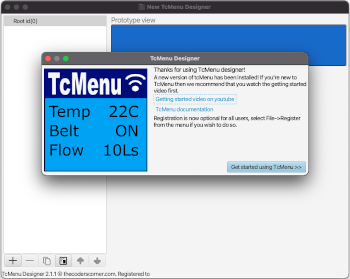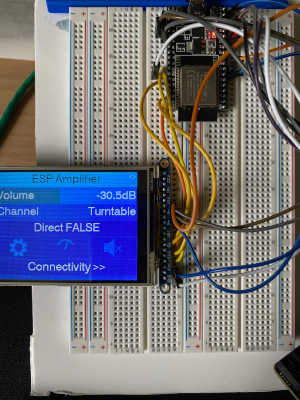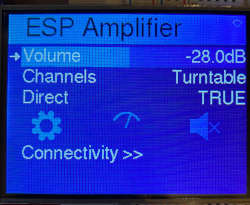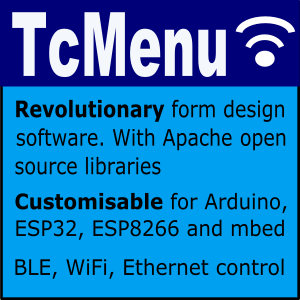New Year 2022 and an update is overdue
It’s been a bit too long between updates, and this is a major update. There are changes ahead for tcMenu, IoAbstraction and TaskManagerIO as I had to make a choice on how much I can do, going forward and for the foreseeable future it is back to my hobby, and the company behind it is closed. I am very happily working permanently and making the audio equipment that I always wanted to make in my spare time.
tcMenu designer 2.2 with improved IoT support and more automated tested
It has been quite a bit more than a week since the last update, but a lot has happened in that time! First, we released version 2.1.3 of the library, and switched the designer to use the 2.1 plugins by default. That means that we’ve opened up themes for everyone to use. We’ve also made it really easy to rollback too.
However, let’s take a look at where we are now, since the move to a single code base for designer. Firstly, we’ve made several releases of the designer with improvements and fixes, it’s far easier now there’s only one code base to test and ensure it works. We are now able to round trip much faster and that should benefit everyone. In the next version you will even be able to choose more than one remote/IoT connector at once.
tcMenu - menu designer 2.1 has been released
We have now released version 2.1 of the menu design software TcMenuDesigner. For all users it is now downloaded from GitHub instead of acquiring from the App Store. We notarize for Mac, package for Linux, and have an extended validation certificate for Windows deployments. So it should be quite easy to install for most.
We initially thought getting it in the App Stores was what people wanted. However, most people seemed either neutral or negative to tcMenuDesigner being installed from the App Store. Further, even really popular developer apps with many users struggle to achieve a rating of 3. Now I know why, it’s really hard with a complex like tcMenu Designer to ensure something won’t break when it auto upgrades, so you end up just not updating it very often, because the risks are too great, with the user unable to revert to a prior version.
TaskManagerIO and asynchronous I2C in IoAbstraction
In the image to the left, you see me debugging hardware I2C (or TWI) from AVR to a PCF8574.
This past week and a bit I realised something, there’s a couple of missing pieces in the core libraries that are really needed to tidy up the last messy pieces in IoAbstraction. Once we move beyond TcMenu 2.0, we expect that it should be enhancements only.
Firstly, we think that task manager lacks one last feature, a suitable generic cross-platform spin locking mechanism. Secondly, the way I2C is done in IoAbstraction is suboptimal, with too many conditional blocks handling different boards. Further it is synchronous often causing delays in task manager.
TaskManagerIO update, tcMenu 2.0 testing, mbed improvements
As promised last week, here’s an inflight update for this week. It’s been a busy week as we get further along in the preparations for tcMenu 2.0, and try to bring mbed further into the fold.
First of the bat this week was to fix the last of the bugs we knew about in tcMenu 2.0 development branch, so as far as we know, anything outstanding is now fixed, and we are ready to do the final testing!!
TcMenu 2.0 - a very complete menu framework / library
I’m going to start writing more frequently about our goals, and the plan is to do it here and share these updates on Facebook and Twitter, to avoid me having to write the core of the article twice. This time around I’m going to cover tcMenu 2.0, where it is, and what’s next.
TcMenu 2.0 BETA designer UIs and Libraries are now available
This is an exciting time for tcMenu, moving further towards a UI framework rather than just rendering line by line. In 2.0 you’ll be able to set menu items out in grids made up of rows and columns, you’ll be able to draw actionable items such as ActionItems, DialogButton, and SubMenus as icons, and those icons could be Xbitmap, or native colour; in an upcoming version we’ll even support palette based bitmaps!
For the first time ever, this site is static generated
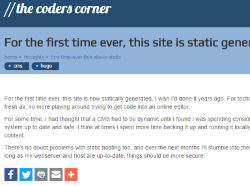 For the first time ever, this site is now statically generated using hugo content templating system, I wish I'd
done it years ago. For technology sites it really is like a breath of fresh air, as there is no more playing around
trying to get code and technical content into an online editor designed for WYSIWYG general purpose blog editing.
For the first time ever, this site is now statically generated using hugo content templating system, I wish I'd
done it years ago. For technology sites it really is like a breath of fresh air, as there is no more playing around
trying to get code and technical content into an online editor designed for WYSIWYG general purpose blog editing.
For some time, I had kept the misconception that a CMS had to be dynamic; that was until I found I was spending considerable time trying to keep my Joomla system up to date and safe. I think at times I spent more time backing it up and running it locally to stage updates, rather than building content.
Impressed with Fedora 19 Linux
After 10 years of service, my old linux box finally gave up so I bought a basic tower to run Linux on. I've got to say that Fedora 19 was very easy to install and get working. Just as with Windows 8, I think the new Gnome 3 interface is an improvement once one is accustomed. Although I did tweak a few things with the tweak tool.
These days, I use a setup of Win7/64 running on a macmini (you read that right - I run windows on my macmini). This machine is used to play back HiRes audio and runs a host of electronics and audio analysis software. This also has a Java development environment and cygwin installed.
What a great summer we had in England
Over here in England we've had the best summer in some years. During a recent week holiday in Devon, we could as well have been in the French Riviera the temperatures were so high. I stumbled across a town called Lynton in the Exmoor region on the way back, and what scenery there - the valley of rocks is certainly worth a visit!
In the town centre there was a small record shop, I don't know the name, but I managed to get half and hour in there to pick up a few records.
Technological advances and AVR chips
Just recently I stopped to think about AVR's. There's something astounding about a chip that costs a couple of pounds and yet has a fully implemented processor, memory, flash, serial IO, ADC and reprogrammable ROM. Just think that's basically almost as powerful as an old 8 bit computer from the 80's in an 8 pin DIP package.
To put that in some perspective, the old 8 bits had countless support chips and their power requirements would be well in excess of any of the ATTINY range of Atmel's chips.

